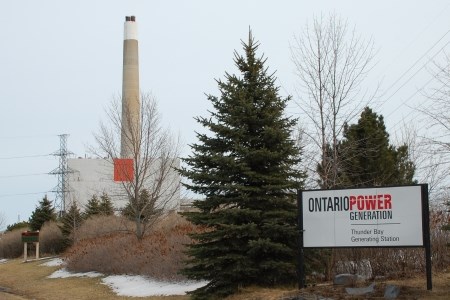A five-year-old plan to convert the coal-burning Thunder Bay Generating Station to natural gas has been dusted off and is being put into play.
Coinciding with the release of the province’s 20-year power strategy in late November, the Ministry of Energy and Infrastructure is moving forward with the conversion of the plant to natural gas. The conversion begins sometime in 2011.
The three-year project fits the McGuinty government’s self-imposed deadline to be off coal at its four Ontario generating stations by 2014.
“This is fantastic news for the employees here,” said Ontario Power Generation’s (OPG) Chris Fralick, who is manager for the Thunder Bay plant and another coal-burner, the Atikokan Generating Station, 200 kilometres to the west.
Last August, OPG announced Atikokan would also be converted, but it will exclusively burn wood pellets.
“We have a future here and we’re excited about the role we can play going forward,” added Fralick.
It was also exciting for Thunder Bay-Atikokan MPP Bill Mauro to deliver the news.
The two conversions preserve 140 jobs in Thunder Bay and between 85 and 90 in Atikokan.
There will be work for local contractors with about 100 construction jobs created and an additional 200 construction jobs in Atikokan, which is a more extensive plant refit.
The Thunder Bay refit involves building a gas connection between the plant and the TransCanada Pipeline, and adding a gas burner to the plant boilers.
A conveyor belt system and coal pulverizers will remain because they may have a future role if the plant were to co-fire with biomass.
Thunder Bay’s two generating units have the capability of producing 306 megawatts but the power output has been 75 to 80 per cent lower in recent years because of forest mill closures.
“Unless there’s a dramatic turnaround in demand in the northwest, we wouldn’t see our input increase significantly on gas and whatever form of fuel we have here,” said Fralick.
Mauro wanted both Thunder Bay units kept operational to ensure there’s a ready supply of power to accommodate new industrial players.
On everyone’s lips in the region are the chromite and base metal mine projects in the Far North, expected to materialize over the next five years, and the massive power requirements needed for the mineral processing.
“If they were considering mothballing or closing a unit, that was not something I was willing to entertain,” said Mauro.
The Thunder Bay conversion had been shelved in 2006 with natural gas prices reaching historic highs.
However, with new North American supply coming online and prices stabilizing, Mauro said Ontario will not be paying spot market prices.
“A long-term power purchase agreement between Ontario Power Generation and the Ontario Power Authority will be in place before any retrofit begins.”
No price tag for both plant conversions has been released.
Mauro has heard those costs could range between $100 million and $200 million for Thunder Bay, and between $200 million and $300 million for Atikokan.
OPG is updating an old conceptual study for Thunder Bay and will come up with the conversion costs and a business plan.
A similar analysis is being done for Atikokan.
OPG put out a biomass procurement call for potential suppliers last March to give the utility a better handle on fuel costs as part of the plan to do the Atikokan modifications.
“It will form an integral piece of the business case that we need to develop before getting ultimate approval (from the Energy Minister),” said Fralick.
With one generating unit at Atikokan, the estimated wood pellet supply will be 90,000 tonnes a year, between one and two per cent of the allowable yield in the forest industry, said Fralick.
The government expects to create 20 to 25 jobs in wood pellet production and sustain other forestry jobs.
Mauro harboured some doubts about the supply and cost of biomass, but he’s satisfied enough research has been done to show that an abundant supply is available.
“As a Northern member, I am not interested in seeing whole logs suddenly being used to create energy.”




